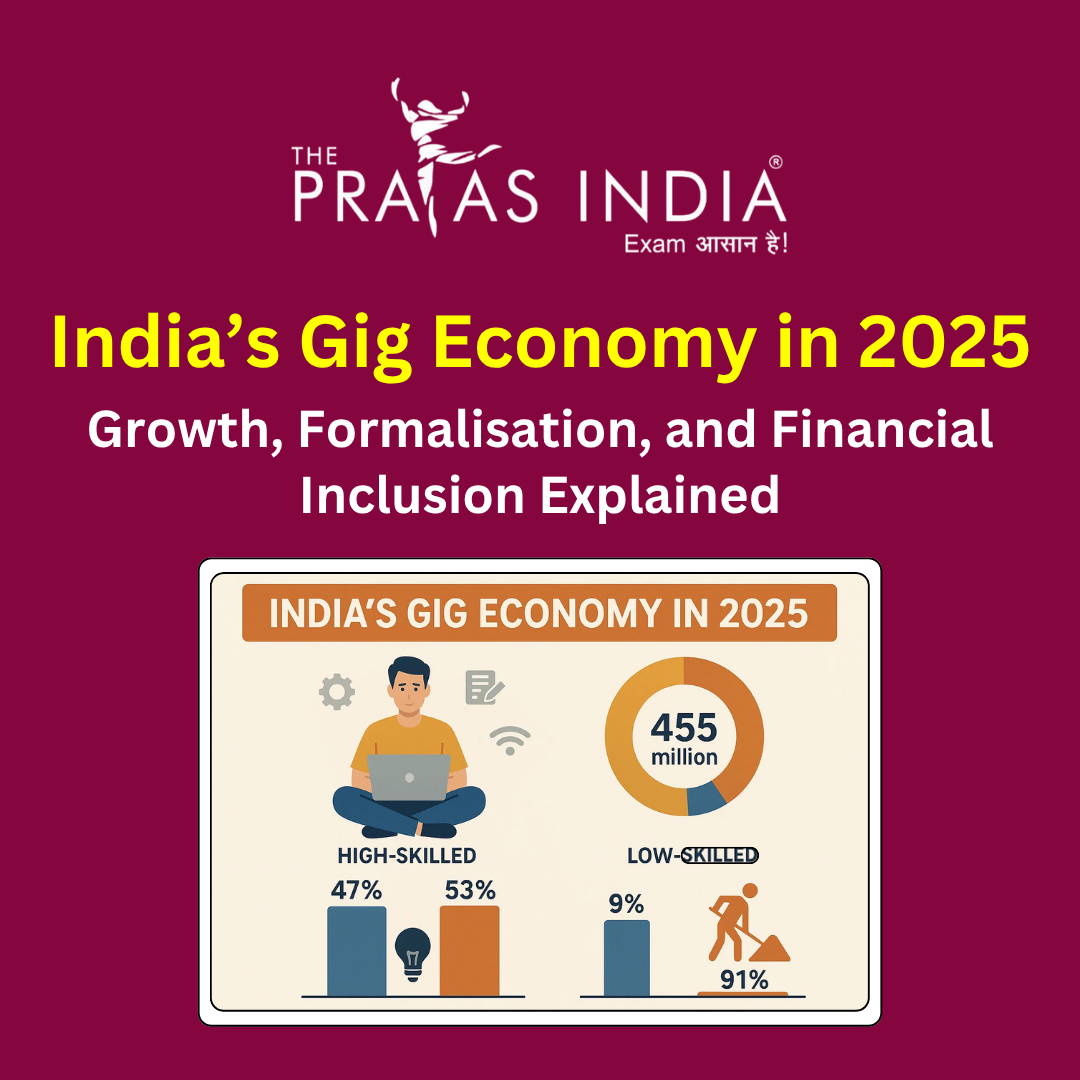India’s Gig Economy in 2025: Growth, Formalisation, and Financial Inclusion Explained
India’s gig economy has entered a new era in 2025. Once considered an informal and uncertain employment sector, it is now rapidly transforming into a recognised part of the mainstream labour market. In FY 2024–25 alone, India witnessed a surge to 12 million gig workers, up from 7.7 million in 2020–21, growing at a CAGR of 17% and a year-on-year increase of 38%. This shift, driven by digital penetration, urbanisation, and changing work preferences, marks a structural transformation in India’s workforce.
But the story is deeper than just numbers. The rising prominence of gig workers is influencing everything from how services are delivered to how credit is extended—making this an essential theme for policymakers, employers, and job seekers alike.
Who Are India’s Gig Workers in 2025?
Gig workers today are far more diverse than stereotypes suggest. They include not only the young working on delivery or ride-hailing platforms but also middle-aged individuals, women, and even retirees performing home services, repair work, or freelance assignments. What unites them is the absence of traditional job security, such as pensions, paid leave, or employer-provided health benefits.
Previously, carpenters, electricians, or domestic workers operated entirely in the informal sector—unregistered and paid in cash. Now, thanks to platforms like Swiggy, Zomato, Urban Company, and Ola, these roles are being digitised, organised, and tracked. These platforms assign tasks, process payments, and provide visibility into worker performance and earnings.
The Impact of Digital Formalisation
One of the most significant changes in recent years is formalisation through digital platforms. By creating structured environments where services are logged, rated, and paid for via formal financial channels, gig platforms have made gig workers visible to the economic system.
For example:
- Payments are made through bank transfers or digital wallets.
- Profiles and skills are recorded and verified.
- Rate cards based on services and ratings offer consistent pricing.
This semi-formal model allows gig workers to build a documented income trail, increasing their credibility in the financial world—a critical first step toward financial inclusion.
Access to Credit: From Invisible to Included
Historically, gig workers were locked out of formal credit systems. They lacked income documents, credit scores, and job security—making banks hesitant to lend. As a result, many relied on informal lenders, which often led to high-interest loans and financial exploitation.
But that’s changing.
With platforms recording income, behaviour, and performance, gig workers now have alternative credit data. Banks and fintech lenders are beginning to recognise this potential and are adjusting their models to accommodate “thin-file” borrowers who lack traditional credit histories.
Financial Innovations Supporting Gig Workers:
- Alternative credit scoring: Uses platform data like ratings, earnings regularity, and completed tasks.
- Embedded finance: Micro-loans and advances offered directly through gig platforms.
- Digital lending platforms: Use behavioural analytics and transaction data.
- Account Aggregators (AAs): Enable workers to share their financial data securely, improving underwriting.
The Road Ahead: Growth Projections and Opportunities
India’s gig economy is expected to reach 23.5 million workers by 2029–30, forming 6.7% of the non-agricultural workforce and contributing 1.25% to India’s GDP, according to the Economic Survey. In the long term, the sector could unlock up to 90 million jobs.
There’s also a qualitative shift underway:
- Rising number of white-collar freelancers in fields like design, content, and coding.
- Increased participation by women, especially in home-based services and flexible roles.
- Emerging Gen Z and Gen Alpha workforce choosing gig work for autonomy.
Persistent Challenges
Despite the promise, several hurdles need attention:
- Income volatility: With no fixed salaries, workers face unpredictable monthly earnings.
- Lack of social security: Most don’t receive health insurance, pensions, or job protection.
- Financial exclusion: Credit access remains limited without targeted reforms.
- Worker safety and rights: Protection against exploitation is still weak.
These concerns highlight the need for policy reforms, inclusive financial tools, and better protections to ensure gig workers aren’t just contributors to economic growth—but also beneficiaries of it.
Conclusion
India’s gig economy is no longer peripheral—it’s central to how work, wages, and wealth are being reshaped in the country. As more Indians embrace flexible, task-based employment, it’s crucial that labour rights, financial systems, and digital infrastructure evolve in parallel.
Gig work is here to stay—and with the right support, it can become a cornerstone of inclusive, sustainable economic growth.


![Prayas-लक्ष्य [UPSC CSE Target] The Prayas India](https://theprayasindia.com/wp-content/uploads/2021/08/Prayas-लक्ष्य-UPSC-CSE-Target-The-Prayas-India-300x167.png)

![Prayas Pre-भेदश [UPSC CSE Prelims Test Series] The Prayas India](https://theprayasindia.com/wp-content/uploads/2021/08/Prayas-Pre-भेदश-UPSC-CSE-Prelims-Test-Series-The-Prayas-India-300x167.png)










